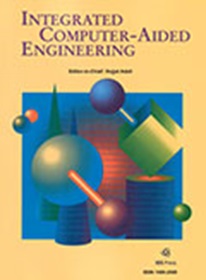Prediction of thrust bearing’s performance in Mixed Lubrication regime
IF 5.3
2区 计算机科学
Q1 COMPUTER SCIENCE, ARTIFICIAL INTELLIGENCE
引用次数: 0
Abstract
A hydrodynamic thrust bearing could be forced to operate in mixed lubrication regime under various circumstances. At this state, the tribological characteristics of the bearing could be affected significantly and the developed phenomena would have a severe impact on the performance of the mechanism. Until recently, researchers were modeling the hydrodynamic lubrication problem of the thrust bearings either with analytical or with numerical solutions. The analytical solutions are very simple and do not provide enough accuracy in describing the actual problem. To add to that, following only computational methodologies, can lead to time consuming and complex algorithms that need to be repeated every time the operating conditions change, in order to draw safe conclusions. Recent technological advances, especially on the field of computer science, have provided tools that enhance and accelerate the modeling of thrust bearings’ operation. The aim of this study is to examine the application of Artificial Neural Networks as Machine Learning models, that are trained to predict the coefficient of friction for lubricated pad thrust bearings in mixed lubrication regime. The hydrodynamic analysis of the thrust bearing is performed by solving the Average 2-D Reynolds equation numerically. In order to describe the roughness of the profiles, both the flow factors suggested by N. Patir and H.S. Cheng (1978) and the model of J.A. Greenwood and J. H. Tripp (1970) are taken into consideration. Three lubricants, the SAE 0W30, the SAE 10W40 and the SAE 10W60, are tested and compared for a variety of operating velocities and applied coatings. The numerical analysis results are used as training datasets for the machine learning algorithms. Four different ML methods are applied in this investigation: Artificial Neural Networks (ANNs), Multi- Variable Quadratic Polynomial Regression, Quadratic SVM and Regression Trees. The coefficient of determination, R2 is calculated and used to determine the most accurate ML method for the current study. The results showed that ANNs provide very good accuracy in the prediction of friction coefficient compared to the rest of the ML models discussed.推力轴承在混合润滑条件下的性能预测
在各种情况下,推力流体动力轴承可能被迫在混合润滑状态下运行。在这种状态下,轴承的摩擦学特性会受到很大影响,所产生的现象会严重影响机构的性能。直到最近,研究人员还在通过分析或数值解法对推力轴承的流体动力润滑问题进行建模。解析解非常简单,在描述实际问题时不够精确。此外,如果仅采用计算方法,则会导致耗时且复杂的算法,每次工作条件发生变化时都需要重复计算,才能得出安全的结论。最近的技术进步,特别是计算机科学领域的技术进步,提供了一些工具来加强和加速推力轴承的运行建模。本研究的目的是检验人工神经网络作为机器学习模型的应用情况,该模型经过训练,可用于预测混合润滑条件下润滑垫推力轴承的摩擦系数。推力轴承的流体力学分析是通过数值求解平均二维雷诺方程进行的。为了描述轮廓的粗糙度,考虑了 N. Patir 和 H.S. Cheng(1978 年)提出的流动因子以及 J.A. Greenwood 和 J. H. Tripp(1970 年)的模型。对三种润滑油(SAE 0W30、SAE 10W40 和 SAE 10W60)进行了测试,并对各种工作速度和涂层进行了比较。数值分析结果被用作机器学习算法的训练数据集。本研究采用了四种不同的 ML 方法:人工神经网络 (ANN)、多变量二次多项式回归、二次 SVM 和回归树。通过计算判定系数 R2,可确定当前研究中最准确的 ML 方法。结果表明,与所讨论的其他 ML 模型相比,ANN 在预测摩擦系数方面具有很高的准确性。
本文章由计算机程序翻译,如有差异,请以英文原文为准。
求助全文
约1分钟内获得全文
求助全文
来源期刊

Integrated Computer-Aided Engineering
工程技术-工程:综合
CiteScore
9.90
自引率
21.50%
发文量
21
审稿时长
>12 weeks
期刊介绍:
Integrated Computer-Aided Engineering (ICAE) was founded in 1993. "Based on the premise that interdisciplinary thinking and synergistic collaboration of disciplines can solve complex problems, open new frontiers, and lead to true innovations and breakthroughs, the cornerstone of industrial competitiveness and advancement of the society" as noted in the inaugural issue of the journal.
The focus of ICAE is the integration of leading edge and emerging computer and information technologies for innovative solution of engineering problems. The journal fosters interdisciplinary research and presents a unique forum for innovative computer-aided engineering. It also publishes novel industrial applications of CAE, thus helping to bring new computational paradigms from research labs and classrooms to reality. Areas covered by the journal include (but are not limited to) artificial intelligence, advanced signal processing, biologically inspired computing, cognitive modeling, concurrent engineering, database management, distributed computing, evolutionary computing, fuzzy logic, genetic algorithms, geometric modeling, intelligent and adaptive systems, internet-based technologies, knowledge discovery and engineering, machine learning, mechatronics, mobile computing, multimedia technologies, networking, neural network computing, object-oriented systems, optimization and search, parallel processing, robotics virtual reality, and visualization techniques.
 求助内容:
求助内容: 应助结果提醒方式:
应助结果提醒方式:


